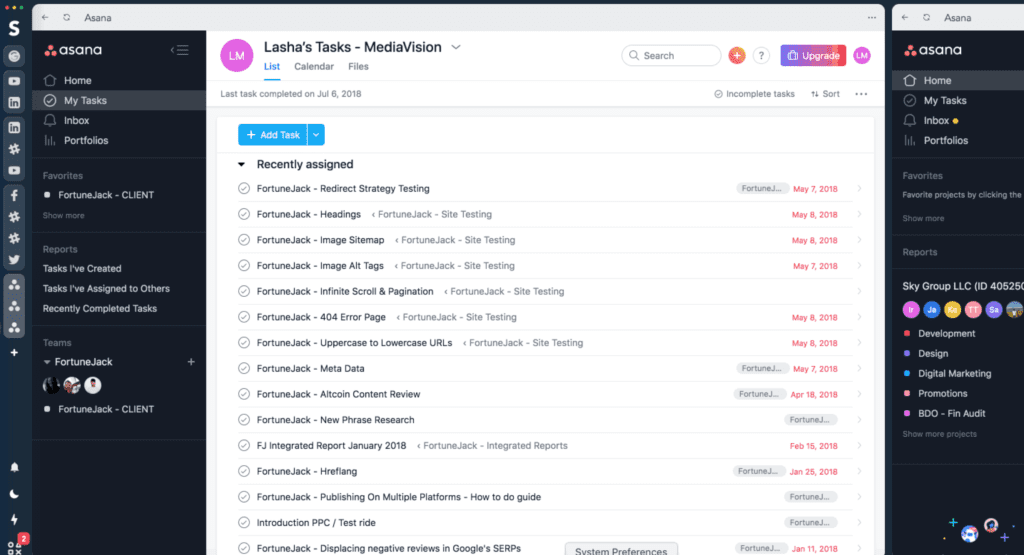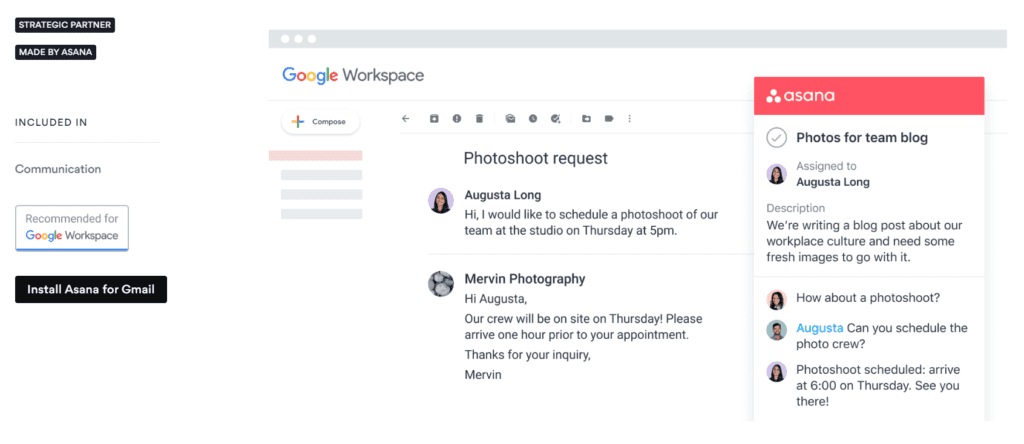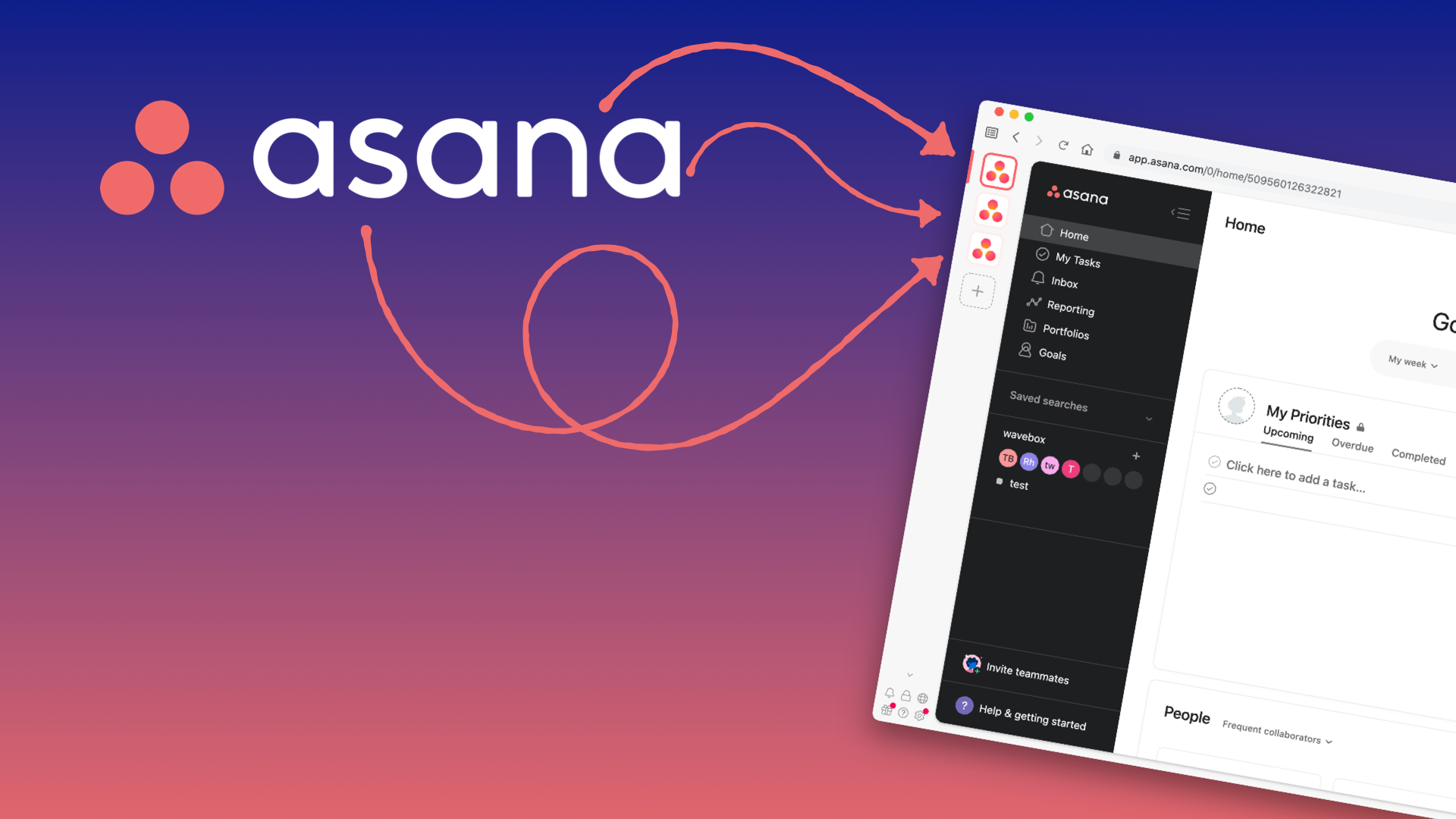FTC Disclosure: We may receive compensation if a site visitor clicks on links and makes a purchase. However, we provide an objective review and we don’t always recommend everything we review.
Asana is an easy-to-use project management desktop software and mobile app for project workflows and task management. It’s free for up to 15 people in a single organization, but you’ll have to upgrade to a paid plan to unlock its full capabilities.
Asana is free to start and easy/fun to use. I use it myself on a weekly basis, just on my own to stay organized and keep my personal email inbox from looking like an overgrown digital jungle. It’s one of the coolest tools I’ve picked up in recent years.
So what’s Asana known for?
Key Takeaways:
- Asana is a cloud-based task management tool that enables businesses to coordinate, communicate, and manage their tasks and projects
- More than 80% of Fortune 100 companies use Asana for workflow management and collaboration at work
- Asana frees up time for employees to focus on higher-value activities and standardizes certain processes in the work progression to eliminate unnecessary errors and risk
$341,700. That’s what Asana claims you’ll make/save per year for your business per 100 Asana users in your organization. That works out to $3,417 per Asana user, in case you don’t have 100 employees, or even if you have more.
All just for using Asana. But is Asana really that good?
Asana unifies a team’s work into a single work management platform, assisting teams in remaining connected and organized. It has a robust collaboration layer for messaging and helps with better managing and visualizing the flow of work.
By putting all of the work in one connected space, Asana powers and streamlines businesses to greater heights. Asana is used by millions of teams and over 100,000 paying organizations all over the world to concentrate on the important work.
Asana Workflow and Project Management Review
Imagine having a giant digital white board like the ones in the boss’s or managers’ office of old where they planned and charted work projects, moved magents and labels around into various columns, but now all employees have access to it and can update it whenever they want for you. They can automatically take on tasks and mark them complete when finished, discuss details within tasks between multiple members, and streamline the entire workflow.
You step out from work and walk across the street to have coffee when a great idea hits you. Instead of looking for a piece of paper to write it down or sending yourself an email, you can just open up your Asana app while in line and drop a comment on an already open task, or start a new one before you can look up and order your latte. Oh, look at that. Sales just completed the overhaul on your email sequences in HubSpot. Task complete. Now it looks like Design’s got it and are already building out the visual assets for it.
Did I mention that you just got your latte? You drop a comment into the task workflow and grab your coffee, wink at the barista and take a sip. Mmmm, that’s good bean.
By the time you get back to the office, your comment has already been seen by the person overseeing the task, and the team has already picked up the ball and run with it in the direction you’d advised. There was no kicking around the idea or scheduling a meeting for next week when everyone’s not busy.
You didn’t miss or skip a beat. You didn’t have to “pop in” and stop/start the workflow or call a meeting.
It just got done.
Plan and Manage More Tasks With Less Time at Work

When comparing life at work before Asana to afterwards in a 2021 IDC white paper sponsored by Asana, users noticed the need for meetings went down by 18%. The total time users spent hunting down information from last week, digging through emails or slogging through administrative tasks went down anywhere from 30 – 50%.
On average, when using Asana, work was completed 13% faster and 34% more projects were completed on time.
All study participants stated that Asana reduced or even eliminated the daily struggles and irritations they usually experienced while carrying out routine tasks like communicating, locating and consuming information, and completing projects.
Benefits of Asana for Business and Employees
For businesses, Asana stands to radically improve employee morale. Giving employees a visual aid tool that auto-manages and organizes tasks is a really great way to see the work you’re assigned and feel accomplishment everytime you complete it and move on to the next one.
Employees reported a 72% increase in employee satisfaction, and have noticed the productivity boost resulting from working within the program, like:
Cross-organizational collaboration and visibility to ensure day-to-day efficiencies: “The most beneficial part of using Asana is having real-time collaboration and transparency for everyone because we are working all in the same tool. It gives you a lot of efficiency in the organization because we’re all on the same page.”
Clarity about task dependencies to advance projects: “With Asana, we’re able to understand highest priority tasks versus not-so-high priority tasks and dependencies … So when we’re talking about completing a task, we understand what are the other things that need to happen for that to be completed.”
Improved quality control with automated templates: “All of our QA processes are better and faster because of the structured process using Asana, especially with developing templates. It’s impacting the way we work.”
More productive technology teams to drive business results: “Asana has allowed our tech teams to grow by almost three times. They all manage their product road maps in Asana so every team can know instantly what each team is working on, and what are the next steps, and the next features that are going to be put out.
It definitely allows us to run out a better product with new features.”
Asana Integration with Slack, Jira, Gmail and More

Jira, Hubspot, MicrosoftTeams, Zoom, Salesforce, Slack, Adobe, Trello, Google Docs and Sheets, and Gmail are all also supported for integration. Asana has been releasing regular product updates that improve metrics, flexibility, and user experience (such as Universal Reporting).
Asana’s adoption of the Asana Work Graph, which is based on graph database technology, is responsible for a large portion of the advanced intelligence that is already available in Asana. By treating each data item (or “node”) as a data point with the potential for correlations, graph databases operate differently from the rows and tables of traditional databases.
Asana Pricing Levels and Cost by Plan and Features
Asana offers the following pricing:
- Basic – Free for up to 15 people – Three of the four project views are accessible with the free plan, with the exception of the timeline view. As long as each file you upload is no bigger than 100MB, you can upload as many files as you like.
You can integrate Asana with more than 100 apps on the free plan, including Slack, Outlook, Google Workspace, and others. Unfortunately, the free plan is deficient in key features like workload, automation, forms, and portfolios.
- Premium – $10.99/month per user when paid annually and $13.49/month per user when paid monthly – The Premium plan lifts the 15 users and 1,000 tasks restrictions. If you’re working with contractors, having unlimited guests—users who can view a project but cannot interact with it—is also very helpful.
The Timeline project view, which enables everyone on your team to see how all the parts fit together, is another benefit of the paid plans.
- Business – $24.99/month per user when paid annually and $30.49/month per user when paid monthly – The Business plan adds a few more features not found in the Premium plan, such as Portfolios, which give you a comprehensive overview of all of your significant projects in one location.
Managers who oversee multiple projects may find this feature useful. The Workload feature also enables you to see how much work your team has to do in order to prevent burnout.
- Enterprise – You must contact Asana directly for this option. Benefits include security at scale and all the aforementioned benefits from previous plans, plus exclusive access to updates and rollouts of new features
Top Companies That Use Asana to Manage Their Work Processes and Customers
Asana is a top-rated enterprise project and task management solution used by Uber, Airbnb, and Pinterest, to name a few. NASA is one more.
Asana Automated Reports and Custom Tracking
Asana’s tracking algorithm and reporting will be essential for generating value in ways that were previously immeasurable. In order to improve processes, Asana can use this data to identify trends, monitor engagement, and track velocity.
This can also be used to take advantage of integrations to build a more intricate data set that can be used to educate employees, managers, and businesses while maintaining privacy.
As an early adopter of this technology, Asana’s user base is already reaping the rewards.
Built-In Productivity and Efficiency Hacks
Asana offers a selection of templates, a shared team calendar, the ability to schedule tasks and control access as well as share files. It’s also great for asynchronous work where people are working remotely from different time zones.
Gantt Charts
Teams can better plan their work around deadlines and allocate resources when they use Asana to create Gantt charts. Gantt charts are another tool used by project planners to keep an overview of their projects.
They show, in addition other insights, how dependent tasks, milestones, and tasks with different start and end dates relate to one another.
Kanban Boards
An agile project management tool called a kanban board was created to help visualize work, reduce work-in-progress, and increase productivity (or flow). The Kanban method, which is frequently used by software development teams, enables teams to visualize the work that needs to be completed given their team’s capacity.
Kanban software is excellent for Agile teams that want to visualize project progress, prioritize tasks, and identify bottlenecks. It is frequently used with Scrum or Agile management. Using the project management tool from Asana, now you can create your own.
Resellers and Integration Expert Partners
If you think Asana is right for your business but you’re not exactly sure how, or you don’t know how to get the most out of it, you can get additional training and oversight by one of Asana’s partners registered on their website.
Asana partners are often regional experts in business scaling and reporting across different countries around the world who are also there to assist you in customizing your account, onboarding teams, and other tasks.
What’s Better Than Asana?
For those who favor a visual method of task management, Monday.com is a fantastic Asana substitute. The platform tracks tasks using “pulses,” which can be customized with different colors, due dates, team members, and notes.
Users can view all the tasks connected to a project in one location by grouping Pulses into “boards” that work similarly to Asana projects. Asana lacks features like time tracking and compliance with the Health Insurance Portability and Accountability Act (HIPAA), but Monday.com does as well.
In order to continue using Asana for specific tasks while utilizing the other features of Monday.com, it also has an Asana integration. Compliance and time tracking can also be done separately in Gusto as well, as there is no real overlap.
Ultimately, Asana will be able to keep track of the average amount of time it takes for personnel to complete important tasks and projects. But it doesn’t have a clock in/clock out function.
My Complaints With Asana
The fewer features in the free version are understandable but disappointing nonetheless. I realize they’re a business not performing a public service free though.
For the longest time, I couldn’t figure out how to edit a comment on the mobile app when using Asana on an Android phone. I eventually discovered that you can edit a comment on mobile, but you must hold down your finger over your comment to bring up a pop-up screen that gives you more options. On the desktop version, you simply click the triangle in the upper right part of a comment near the thumbs-up icon for the edit option.
Also, notifications about task deadlines seem to show up randomly. Thus, I end up having to go back into Asana from time to time and review tasks on my board manually for the deadline.
And one more warning: uploading a ton of images or files into the task comments field can cause the app to take longer to load due to the extra bandwidth required to load all the images.
Conclusion: Asana Reviews
I use Asana regularly. It’s one of my most-used apps on my phone and it’s always open in my desktop browser when I’m working to keep me on task. I find myself using it in my car to record ideas, then come back later on my laptop with the browser version to clear the queue.
I have a basic membership where I use Asana for my own business and life for free. I’m also typically the kind of guy who likes to write things down and have a notebook handy to stay organized, and Asana has more or less replaced that.
Professionally, I’ve used Asana at two different marketing companies with more than 75 employees apiece and it worked really well. It’s also pretty easy to use, which I value the older I get.
Visit Asana to see if it’s right for you.
Frequently Asked Questions – Asana Workflow Software and App
Asana has integration with Jira, Salesforce, Outlook, Google Calendar, Teams, Gmail, HubSpot, Slack, and Quickbooks, to name a few. Instructions for implementing Asana integration can be found through a helpful guide on their website.
Asana is useful for solo entrepreneurs as well as small businesses looking to effectively scale their project workflow and task management/completion from one up to thousands of people, with the ability to share and update images and work files, receive notifications, and track progress in a simple, clean dashboard.
Asana offers a free version to desktop and app users- up to 15 people within an organization before you’ll have to pay. The paid Asana version offers greater admin and control over project workflow with timelines, forms, milestones, and a global progress view. The paid version also allows you to add a start date to a task, as opposed to just a deadline.
